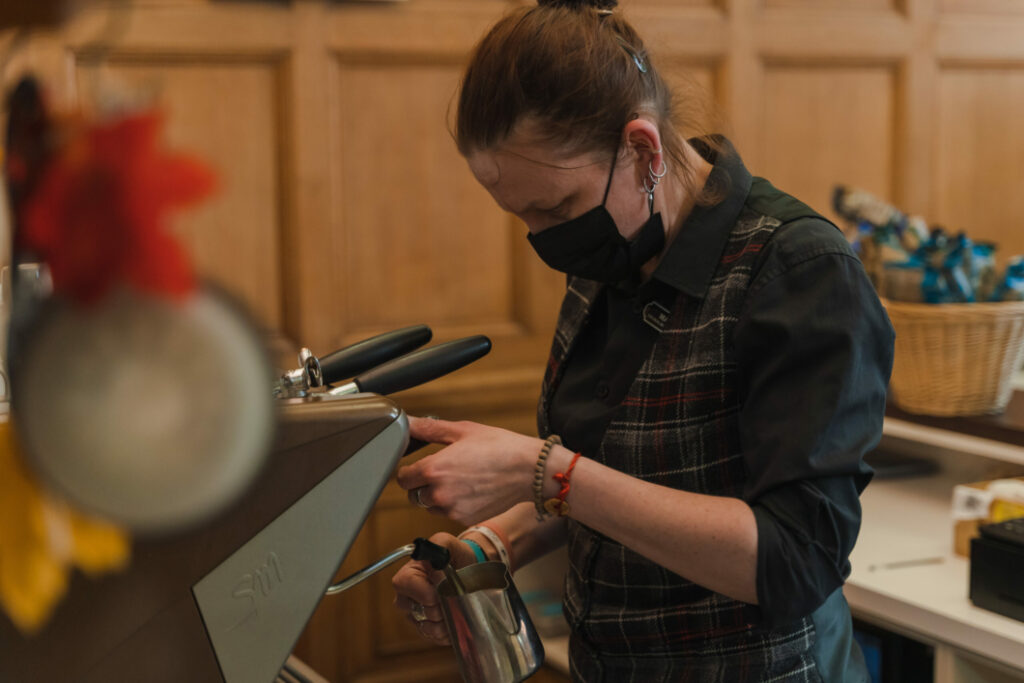10 Years of The Real Mary King’s Close Tartan

In Partnership with Kinloch Anderson.
2023 marks the 20th anniversary of The Real Mary King’s Close. To commemorate two decades of running tours, we’ve been looking back at our more recent past to celebrate the people who have helped to make our attraction the 5-star visitor experience that it is today.
A large part of that success can be attributed to our Guest Services team members. They are the front-line staff who work hard in our Admissions Office, Gift Shop and Café. They ensure that all visitors have the best possible time at our site before and after they complete their journey beneath The Royal Mile.
They’re easy to spot! All of our team uniforms consist of either a tie, waistcoat or kilt embroidered with our signature The Real Mary King’s Close tartan. The design was created by local kiltmakers at Kinloch Anderson for our 10th anniversary back in 2013.
This month, in partnership with Kinloch Anderson, we are exploring the symbolism behind The Real Mary King’s Close tartan and how its rich patterning weaves the story of the closes with the local history of tartan-making itself. Read on to find out more about what Kinloch Anderson had to say…
SHADES OF EDINBURGH
What do the colours in The Real Mary King’s Close tartan represent?
LAYERS OF GREY
Edinburgh is affectionately known as ‘Auld Reekie’. The nickname is Scots for ‘Old Smokey’, and originates from the days when the coal fires in the Old Town polluted the city. The shades of grey used in the tartan reference this, Edinburgh’s famous architecture and the imposing Castle rock.
The different depths of grey also reflect the different levels of Mary King’s Close itself. The shady tones give a nod to Edinburgh’s dark past and the ghost stories which are part of the Old Town’s rich heritage.
RICH RED
The rich red links the tartan to its location on the Royal Mile, with the Royal residences of Edinburgh Castle at one end and Holyrood Palace at the other. Red is used throughout the Stewart tartans, most famously in the iconic Royal Stewart. The double red overcheck references the Stewart Old tartan.
BRIGHT WHITE
The white celebrates the life that thrived in the city and the prosperous period when Edinburgh took a leading role in the Scottish Enlightenment, contributing to original thinking in philosophy, economics, literature and scientific innovation.
HUES OF HISTORY

How does The Real Mary King’s Close tartan pay tribute to Edinburgh’s past?
The colours represent the story of the city, dark to light referencing both aspects of Edinburgh’s history. The red highlight references the city’s royal connections but also its bloody past. The Old Town’s history is full of dark stories of betrayal and treachery, war and witch trials, the plague and murder.
On the lighter side, the city enjoyed the Scottish Enlightenment. The period contributed to the growth and prosperity of the city in art, politics, science, medicine and engineering. Famous Scots like Robert Burns, David Hume and Adam Smith were part of this burst of intellectual and scientific achievement.
A SPIRITED CITY

How does The Real Mary King’s Close tartan link Edinburgh’s heritage with the present day?
The Royal Mile is full of history; but also full of visitors to the city and people working in its municipal buildings. Rich red doors can be seen down the street, and two iconic red phone boxes are just next to the castle. John Knox’s house is painted in a bright white. The grey Castle, along with Holyrood Palace, also frame a picturesque walk.
Edinburgh has always been a thriving and progressive city with a unique personality. The “Awakening of Edinburgh”, followed by the Scottish Enlightenment, set out on a path of progress in all areas.
Nowadays, it continues to be a centre of culture and progress. The city comes alive during the Edinburgh Festivals, which highlight and celebrate the Arts, Literature and Science. The tartan celebrates both historical and present-day life on the Royal Mile. The colours are relevant for what is happening now and what has gone before.
EDINBURGH AND TARTAN

What is Edinburgh’s historical connection to tartan-making?
Mary King was a fabric merchant herself and used to sew for a living during the 17th century. However, it wasn’t until George IV’s visit in 1822 that Edinburgh experienced a turning point in the story of kilts and tartan. Tartan fabric was commissioned on a scale never seen before. Kinloch Anderson started as bespoke kiltmakers just off the Royal Mile in 1868.
Today, after six generations, Kinloch Anderson works in close contact with The Scottish Register of Tartans, which ensures that the recording of tartans is placed in the public domain and safeguards Scotland’s tartan heritage. Every thread and colour in a Kinloch Anderson weave has a meaning, celebrating the heritage of the individual or organisation.
KINLOCH ANDERSON
What is the connection between The Real Mary King’s Close and Kinloch Anderson?
The two companies have a long history and the relationship seems natural. Both are Edinburgh based but globally recognised. Both care about preserving Scottish heritage and enjoy working with people who hold Edinburgh and Scotland close to their heart. It is the quality of service and product offered by The Real Mary King’s Close that makes it one of the most popular attractions in Edinburgh.
Likewise, Kinloch Anderson offers excellent service and value to its partners and customers. Experience is at the core of the business. For Kinloch Anderson, it was important to create a tartan which represented The Real Mary King’s Close, its stories and its people, making the staff proud to wear it. Also, to sell it to those who want to bring a little bit of Edinburgh back home with them that tells a story of rich heritage and deep history.
Book a tour at The Real Mary King’s Close today.








